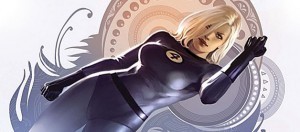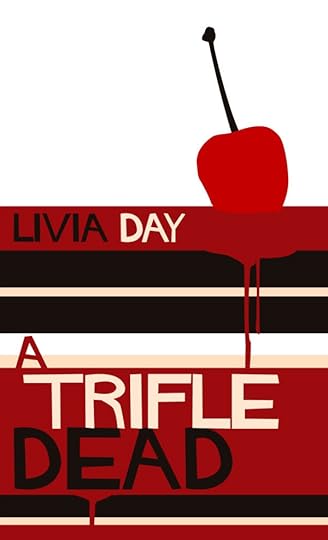Tansy Rayner Roberts's Blog, page 98
October 22, 2012
Hack, Slash, Squish: Gender and Sex In Season One of Game of Thrones
 THIS POST SPOILS ALL THE THINGS FOR SEASON ONE.
THIS POST SPOILS ALL THE THINGS FOR SEASON ONE.
PLEASE DON’T SPOIL SEASONS 2 OR 3 IN COMMENTS. NO I HAVEN’T READ THE BOOKS EITHER.
OK everyone’s way ahead of me on this one, even (to her great delight), my Mum. Once I actually sat down to watch this first season of Game of Thrones, I found myself enjoying it way more than the waves of (mostly feminist) internet critique suggested I would.
There’s a lesson in that somewhere, possibly. Anyhow, here are my reflections on the show:
[Warning, text probably not work safe, though the images should be fine, presuming that your workplace is non judgemental about fantasy fiction as a whole, which is presuming quite a lot, really, what do I know, my workplace is me and the three-year-old. She hasn’t watched the show.]
TEN THOUGHTS ABOUT GAME OF THRONES SEASON ONE:
1. SEX.
The sex scenes are quite confronting early on, not because they are graphic (you’ve read my books, right?) but because they are so uniformly degrading to the women involved. I think it’s interesting that in the first couple of episodes, almost every coupling involves the woman being “taken roughly from behind”, and apparently not enjoying herself all that much in comparison to her male partner. Even the incestuous shag on a tower that is plot-relevant does it that way, and that’s the one that felt to me least convincing. If the queen was going to go to all the trouble and risk of shagging her brother, why wouldn’t she want to look him in the face while doing it?
Oh, wait, answered my own question there.
The main trouble of course with the repetition of this ‘ladies, grit your teeth and think of Valhalla’ attitude to sex in the early episodes, apart from the fact that it makes the Game of Thrones smutty bits boring very fast (I don’t think that was the effect they were going for?) is that the actresses involved (and to some extent the actors) look as if they are mostly worried about not falling over.
Find a bed, people. Fewer potential health and safety problems!
 2. DAENERYS
2. DAENERYS
This leads me to Daenerys, the character who progressed from being a political pawn handed over as marriage meat to a woman taking charge of her own destiny. Yes, sometimes getting to face your husband while having sex with him counts as character development!
I know that many people were upset by the first scene in which the consummation of her marriage is framed as a rape scene, and understandably so. Luckily for me I had read so much analysis of this scene ahead of time that I was prepared for it. I don’t want to be one of those people who is all ‘hey it’s historically accurate so it’s FINE’ but in this case I think you can argue that her powerlessness in the early episodes are an essential part of her character arc. Which doesn’t make it less distressing.
They were going for shock value in the first episode, that much is certain, and while I found Daenerys’ progression through season one quite satisfying at a narrative level, it’s hard to avoid the fact that the actress’s body is repeatedly depicted in disturbing and unsettling ways to convey truths about the culture of this world that could probably have been done in subtler ways.
It’s also very uncomfortable to see that a big part of her story is that of a white woman learning to take command of the ‘savage’ brown people, and I see why many people find that aspect hard to stomach. Personally I think that is at least partly balanced out by the fact that Daenerys’ equally blond brother is the most horrible person on that particular continent, and that conquering and escaping his influence is such a big aspect of her character arc, but I’m not going to argue with anyone who finds the racial aspects of this story a major turn off.
I do have to admit that thanks to the version of this we watched (our DVD player is so crappy we have to rip copies & watch through airplay to get a half decent picture) we um, didn’t get any subtitles. So chances are we missed a lot of subtleties in the Khal-Khaleesi scenes.
From a gender point of view, I found Daenerys to be a compelling example of historical/fantasy women who find power even when the society is determined to keep them powerless. There are lots of those women in this show, more than I expected to find.
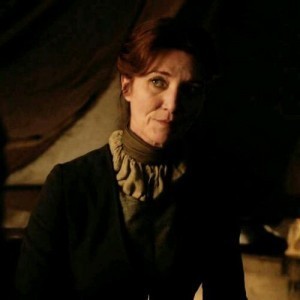 3. SPEAKING OF WOMEN TAKING THEIR OWN POWER, CATELYN STARK.
3. SPEAKING OF WOMEN TAKING THEIR OWN POWER, CATELYN STARK.
Catelyn is set up very much as the wife and mother, matriarch to a large household, but right from the start we see her political awareness and interests. And yes, a big driving force of her in this story is her fury and determination to avenge the hurt done to her youngest son (ie an extension of her motherly duty), but I love the fact that in a show that talks constantly about ‘woman’s weapons’ (i.e. Poison) and is wall to wall prostitutes, we get a grown up lady character who leaps on a horse and rides from one end of the country to the other to get justice.
Sure, she’s not always right, but damn she’s feisty! You can see what Sean Bean saw in her. After HBO’s Rome it’s really nice to see a matronly character who gets to do more than snipe at people at parties. Not that the women of HBO’s Rome didn’t snipe brilliantly at parties, but sometimes ladies over thirty years old do like to get out and about and have adventures.
I also really enjoy Catelyn role in the later episodes of the season, where she has to watch her eldest son become a war commander, and is quite blatantly restraining herself from treating him like the baby boy he is.
I have forgiven her, in other words, for not being Jennifer Ehle. Just.
4. LATE BREASTFEEDING = INSANITY WTF “Oh, Humperdinck. You just weren’t blond enough for me.”
I have OPINIONS about the gratuitous use of the ‘woman breastfeeds a child past the traditional age of breastfeeding in order to show she is batshit crazy’ trope that we got more than once with Catelyn’s sister. But you can probably guess what those opinions are. So let’s move on. (I noticed what you did there, HBO, and it made me cranky)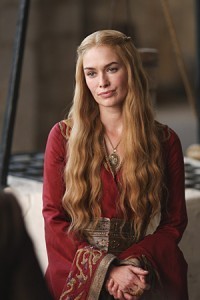
Speaking of sniping indoors, it’s a good thing that this isn’t Catelyn’s specialty, because Cersei Lannister would wipe the floor with her. I am loving this character, her villainous charisma and her utter ruthlessness. Who would win in a duel between Cersei and Atia of the Julii? I don’t know but I would watch the hell out of that show!
It’s so rare to get a really crunchy female villain who is also allowed to be human and intelligent, and Cersei is both. I particularly liked the scene where she and her husband, Henry VIII (I know he has a real name, but come on, who are we kidding here?) sat down and had a frank discussion about their history and their marriage, even managing to share a bittersweet joke or two. There are so many layers in this show, and I think the way that the effect of arranged marriages have on a society from a psychological point of view comes across in a complex and interesting way.
Mostly, though, Cersei terrifies me. I found myself constantly yelling advice inside my head to various characters along the lines of DO WHATEVER CERSEI WANTS, YOU DON’T WANT TO UPSET HER! Powerful lady is powerful.
I do find it a little disconcerting how much this devastating, cruel and ruthless woman looks exactly like Buttercup from The Princess Bride. Once you have seen it, you cannot unsee it! You’re welcome.
6. SEXPOSITION FOR FUN AND PROFIT
I’m sure I didn’t invent the word ‘sexposition’ – apart from anything it has to be scrawled in mile high letters on every whiteboard at HBO studios, right? I do find it deeply amusing, though, how many of the ‘now it’s time to explain the political infrastructure/historical climate/weather/dragons’ scenes are conveyed while two characters are slightly distracted by having sex with each other, or watching sex occur across the room.
Occasionally the children do get to play the exposition game by doing their homework loudly or being randomly verbally tested by adults, but these scenes are about 1 to every 4-5 sexposition scenes.
This, fantasy writers, is now to deal with info dump. ADD SMUT! While much of the sexposition is utterly gratuitous, I cannot disapprove, because once you realise what they’re doing (apparently George RR has publicly admitted that is exactly what they’re doing) it is hilarious.
7. SQUELCH.
The person most deserving of an Emmy for Game of Thrones is whomever is in charge of sound effects. Sure, the scenery is gorgeous and beautifully rendered, the performances are awesome, and so on, but have you HEARD what happens during gory death scenes (cough, and many of the sexposition scenes)? Squelch squelch squelch.
8. THE PROSTITUTION SATURATION.
So, prostitutes. There are a metric ton of prostitutes and brothels in this story. That’s how you know it is gritty and “realistic,” right?
 Well, um, yes, to a point. From a historical perspective I think that this aspect of society often gets ignored or rendered invisible in history/fantasy fiction, and it’s a pretty vital aspect to many societies and how they function. I do appreciate the fact that this is depicted in Game of Thrones as an everyday part of life, and that the sex industry is not always glamorised, nor treated as the most degrading thing in the universe.
Well, um, yes, to a point. From a historical perspective I think that this aspect of society often gets ignored or rendered invisible in history/fantasy fiction, and it’s a pretty vital aspect to many societies and how they function. I do appreciate the fact that this is depicted in Game of Thrones as an everyday part of life, and that the sex industry is not always glamorised, nor treated as the most degrading thing in the universe.
But oh boy. This show is so very proud of the fact that it is edgy enough to include prostitution, isn’t it? So, so proud of themselves. I think they could pare down the scenes and references by about half and still get the effect they need. And possibly occasionally have a whole episode in which it’s barely mentioned. You’d think.
The scripts Game of Thrones have made a fair stab at humanising the women involved, giving actual characterisation to some of the prostitutes/sex slaves such as Roz the redhead from the Stark local brothel, Daenerys’ servant who teaches her how to pleasure her husband, and Tyrion’s girlfriend Shae. The ‘truth game’ scene in the final episode in which Shae challenges every cliche Tyrion believes about the type of woman she is, and he in turn reveals why he is such a gratuitous hirer of women, goes a long way to redeeming the prostitution saturation of the show.
But the scenes in which prostitutes are used as set decoration, saucy punctuation to a scene, blokey jokes, sexposition, random nudity, to make Catelyn Stark do that shocked face, to prove that Tyron Lannister is awesome at the sex, orgies, and so on, far outnumber the handful of scenes in which the women in question get speaking lines and/or to show that they are humans.
Is the sex industry as thematically significant in the books as it is in the TV show? Or is this just an excuse for the show to have lots of sexposition while keeping many of the other female characters “pure”? Cos I have to say, there isn’t a whole lot of happy marital/romantic sex in the show to balance it out.
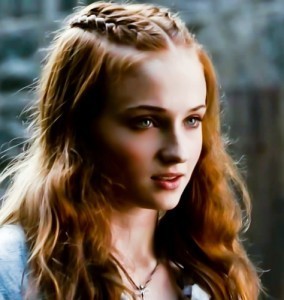 9. THE CASE FOR SANSA STARK
9. THE CASE FOR SANSA STARK
I’ve heard that there is a great deal of hatred directed at Sansa as a character, which seems odd to me – sure, she’s less easy to like than her honest, plucky and sword-mad little sister, but she’s also a young woman who has been placed in an impossible, completely vulnerable position.
Yes, she’s a collaborator, and every time she is put in a difficult position, she does exactly what she is told to do, the most political choice to stay on the right side of the ruling power. But what options does she have?
Apparently many people were surprised when Ned Stark got beheaded at the end of Season One. We found ourselves quite bewildered that he survived as long as he did. Man, he was all pride and no compromise, wasn’t he? Sansa’s father’s imprisonment and death shows exactly what happens to those who rebel against the Lannisters and their cruelty. He could have compromised, have bent his ideals and lived to win at a more politic moment, but instead he chose to let his honour hang out where it could be seen by everyone, and he got it chopped off along with his head.
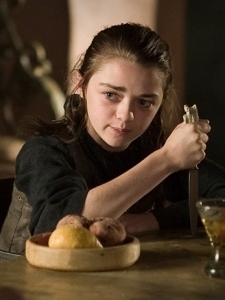 Arya makes exactly the same types of choices as their father – she refuses to compromise her honour or what she believes in, regularly voices her outrage, and only through sheer luck and the support of people around her manages to survive the season. She doesn’t live because of her actions or because she is clever, but because the circumstances of the story (and the author himself) did not yet choose to punish her.
Arya makes exactly the same types of choices as their father – she refuses to compromise her honour or what she believes in, regularly voices her outrage, and only through sheer luck and the support of people around her manages to survive the season. She doesn’t live because of her actions or because she is clever, but because the circumstances of the story (and the author himself) did not yet choose to punish her.
Which is not to say Arya is not cute and awesome, particularly when learning her sword skills, because she is. But I think it’s worth discussing the fact that the female characters who become fan favourites often do so because they are perceived as ‘cool’ and often that coolness is defined as ‘acts like a male character while being cute’. Arya’s an easy character to like.
Sansa, though, has no lucky breaks or carefully-placed allies. Abandoned in a court with no friends and a father whose ideals are more important to him than the safety of his family (I’m not saying ideals or honour are bad, but diplomacy was not Ned Stark’s superpower, and he could have done a much better job of getting his daughters out of the city before he decided to dig his heels in and make a stand for those ideals), all she can do is what vulnerable aristocratic women have always done – she makes concessions.
Sansa’s only mistake is to assume that doing everything that Cersei Lannister tells her is the best option, and that she will be in a position to help those she loves by behaving as a ‘good girl.’ It’s hard to argue that she made the wrong choice even then because all the available information suggested it was the best path.
It’s Joffrey’s lack of respect for ‘the rules’ that throws everything out of the window, and the shock on Cersei’s face when he decides to play tyrant all on his own makes it clear that she would certainly have not made those same choices. So Sansa is stuck, an abused girlfriend to a mad young king, and she’s the one who has to watch her father beheaded in front of her – no one shields her eyes as they do with Arya! It’s too late for her to start investing in a “dance master” of her own. All she can do is keep nodding and smiling and hoping that a chance may come, some time in the future, to make things better for herself.
Sansa and Ned both represent extreme examples of reaction to an impossible situation, the rock and the hard place. They’re both screwed, but she at least is still alive, and where there’s life there’s hope, right?
I really hope there’s hope. I worry about her.
Arya, meanwhile, I don’t worry about much at all. I can tell an author’s favourite when I see one!
10. MY WISHLIST FOR SEASON TWO
(this is not an invitation to tell me what actually happens, I know you’ve all seen it already)
*Everyone is happy and no one has any problems ever again. Okay, that’s probably not realistic. Let’s try:
*Cersei enacts some measure of control over Joffrey, now she’s got over the shock of having raised a right little psychopath. We’d all rather have her on the throne than him, right? Right?
*No one rapes anyone.
*Some form of unionism for all the prostitutes since they are obviously the key to the economy of the Seven Kingdoms. They kick out Littlefinger and start running their own damn brothels, with adequate healthcare.
*Daenerys gets to interact with SOMEONE in the rest of the main cast.
*Ditto Jon Snow.
*Tyrion Lannister and Catelyn Stark team up to fight crime.
*Arya rescues Sansa because someone has to, and she should use her jammy luck for the greater good.
*Winter actually turns up.
*At least two characters have enjoyable sex without paying for it or somehow suffering because of it.
*Tyrion rides into battle again because the look on his face last time was priceless.
*A death scene even funnier than Daenerys’ brother and the “gold crown” which was pretty awesome.
*Dragons dragons dragons.
*More jousting.
*No one rapes anyone. Yes, it was worth saying twice.
October 21, 2012
Where the Wonder Woman Are: #27 The Invisible Woman
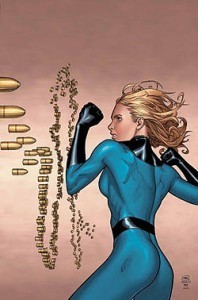 Sue Storm/Richards, AKA the Invisible Girl, AKA The Invisible Woman, has at various times in her long career with The Fantastic Four reflected everything that is bad and mishandled about the writing and general depiction of female superheroes – from the early days in comics all the way through to Jessica Alba’s revelation that she was told not to express any emotion in the Fantastic Four movies, because it might make her look unpretty for a fraction of a second. And let’s not forget all those stupid jokes whereby her invisibility powers lead to her being accidentally naked in public whenever a writer, director or artist wants to add a bit of cheesecake slapstick. But it’s not all doom and sexism, and the Invisible Woman is generally regarded as one of the most intelligent & powerful women of the Marvel comics universe today.
Sue Storm/Richards, AKA the Invisible Girl, AKA The Invisible Woman, has at various times in her long career with The Fantastic Four reflected everything that is bad and mishandled about the writing and general depiction of female superheroes – from the early days in comics all the way through to Jessica Alba’s revelation that she was told not to express any emotion in the Fantastic Four movies, because it might make her look unpretty for a fraction of a second. And let’s not forget all those stupid jokes whereby her invisibility powers lead to her being accidentally naked in public whenever a writer, director or artist wants to add a bit of cheesecake slapstick. But it’s not all doom and sexism, and the Invisible Woman is generally regarded as one of the most intelligent & powerful women of the Marvel comics universe today.
The Fantastic Four, usually made up of Reed Richards (Mr Fantastic), Sue Storm-Richards, Sue’s brother Johnny (the Human Torch), and Reed’s friend Ben Grimm (the Thing) who all received their powers from exposure to “cosmic rays” on the same space flight, are always pitched as being a ‘family’ of superheroes, which is what makes them different to other super teams. In the ‘Silver Age’ early days of their team they represented a move towards comics stories based on science rather then mysticism, and their stories have often involved sci-fi tropes such as space travel, miniaturisation, mad scientists, interdimensional travel (such as to the Negative Zone) and so on.
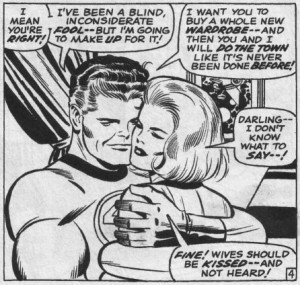 When I was reading up on Jean Grey, I heard her referred to as “a Stan Lee girl” and Sue suffers from that too, before and after her marriage to Reed Richards – she was created and originally represented as the token girl on the team: the pretty one who made the supper, had a far less militant (more defensive) power than the boys and acted “maternally” towards them, providing a calming influence when any of them lost their temper. When not playing little mother to the gang, “the Invisible Girl” was often positioned as the damsel in distress, an object of lust for various antagonists to the Fantastic Four, especially Doctor Doom and Namor the Sub-Mariner.
When I was reading up on Jean Grey, I heard her referred to as “a Stan Lee girl” and Sue suffers from that too, before and after her marriage to Reed Richards – she was created and originally represented as the token girl on the team: the pretty one who made the supper, had a far less militant (more defensive) power than the boys and acted “maternally” towards them, providing a calming influence when any of them lost their temper. When not playing little mother to the gang, “the Invisible Girl” was often positioned as the damsel in distress, an object of lust for various antagonists to the Fantastic Four, especially Doctor Doom and Namor the Sub-Mariner.
Like Jean, Sue Storm-Richards was substantially overhauled as a character more than twenty years ago, her powers expanded and her role given greater significance. The change came primarily when John Byrne, one of the great comics writers for female characters, was brought to the Fantastic Four title in 1981. Sue developed forcefield powers, became far more confident and assertive, and rebranded herself as The Invisible Woman.
At the same time, the first fractures were shown in Reed and Sue’s relationship, and she walked out for the first of many near-divorce scenarios that led to fan resentment and anger towards her character.
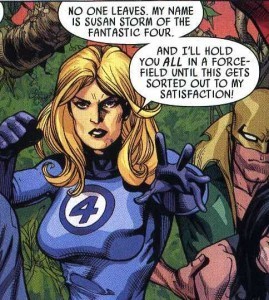 Sue is a trained fighter as well as the possessor of great powers – like Kitty Pryde, her abilities are only limited by the imagination of her writer, and can be used in all manner of inventive and fierce ways. She is often portrayed as having leadership abilities, though she only gets to be actual leader of the Fantastic Four when Reed is otherwise engaged. This seems a bit backwards to me considering that he’s basically the quintessential boffin which doesn’t necessarily translate to leadership qualities. But of course, he’s Mr Fantastic, and it is often hard for writers to overcome traditions that have been ingrained in the comics for so many decades.
Sue is a trained fighter as well as the possessor of great powers – like Kitty Pryde, her abilities are only limited by the imagination of her writer, and can be used in all manner of inventive and fierce ways. She is often portrayed as having leadership abilities, though she only gets to be actual leader of the Fantastic Four when Reed is otherwise engaged. This seems a bit backwards to me considering that he’s basically the quintessential boffin which doesn’t necessarily translate to leadership qualities. But of course, he’s Mr Fantastic, and it is often hard for writers to overcome traditions that have been ingrained in the comics for so many decades.
Sue also is one of the few mothers in the Marvel Universe, where time travels like treacle, and any sign that characters are ageing is usually avoided like the plague. Reed Richards has been allowed to age gracefully, with discreet greying temples, but Sue still looks as blonde and perfect as she always did. Still, their children Franklin and Valeria are a ticking time bomb, and have been creeping closer and closer to ‘teen superhero’ age over the last 30+ years, which would automatically mark Sue and Reed out as belonging to a former generation.
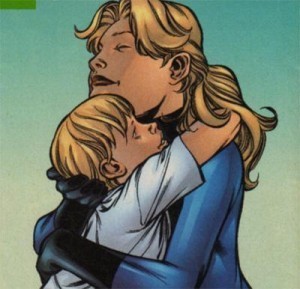 Both children have been involved in major FF related plots, with son Franklin displaying major mutant powers at an early age (which were “shut down” by Reed, causing one of many marital disputes between himself and Sue), and daughter Valeria visiting them from the future before retrospectively taking the place of a previously stillborn baby. Sue has left the team on various hiatuses over the years, usually because of the needs of the children or problems with her marriage, but always returns.
Both children have been involved in major FF related plots, with son Franklin displaying major mutant powers at an early age (which were “shut down” by Reed, causing one of many marital disputes between himself and Sue), and daughter Valeria visiting them from the future before retrospectively taking the place of a previously stillborn baby. Sue has left the team on various hiatuses over the years, usually because of the needs of the children or problems with her marriage, but always returns.
Their marriage, for all its dramas and problems along the way, has remained constant, something rarely seen (long-term) between two active superheroes in either DC or Marvel.
In Civil War, the Marvel event based around the compulsory registration of superhumans, Sue disagreed strongly with her husband’s support of Tony Stark and his deep focus on science over human ethics. She left him in spectacular fashion, using her forcefields to blast a hole through the building as she went, but also left her children with him, something I was taken aback by.
Then of course I had to stop and think, why is this so distressing to me? Surely the point of this is that leaving her children was a sign of how very wrong the situation was, how deep her concerns. Plus it’s kind of awesome that a married lady can run off and live as an underground freedom fighter with Captain America, because of her beliefs, right?
Well, yes, it is awesome, and I am well aware that it’s my own preconceptions about motherhood that got in the way here, but frankly the part where it all falls down for me is that I wouldn’t trust Reed Richards to keep a pet hamster alive. Lucky that Franklin and Valeria are quite resourceful as children, really. Oh and they are occasionally allowed a nanny, though on at least one occasion the nanny in question turned out to be a version of their mother from the future.
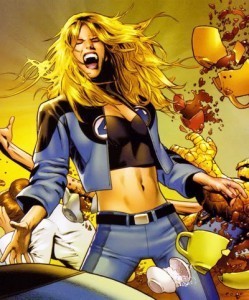 The Ultimate Universe which has not always been kind to its versions of the female Marvel superheroes, produced a spectacular and highly enjoyable version of The Fantastic Four. Taken back to a time where they are teenagers, educated in a special school for scientific geniuses, this version presents Susan Storm as an accomplished scientist in her own right, and one whom the young, geeky and far more likeable Reed Richards believes is smarter than him.
The Ultimate Universe which has not always been kind to its versions of the female Marvel superheroes, produced a spectacular and highly enjoyable version of The Fantastic Four. Taken back to a time where they are teenagers, educated in a special school for scientific geniuses, this version presents Susan Storm as an accomplished scientist in her own right, and one whom the young, geeky and far more likeable Reed Richards believes is smarter than him.
She doesn’t agree, especially in the area of physics, but is prepared to concede that he is certainly an idiot. In particular, it’s Susan who is drawn to studying how their unexpected superpowers actually work, and to test their parameters. Finally, reinvented for the 21st century, Reed and Susan are presented as a couple who are also equals, and it’s amazing the difference it makes.
Also, banter. Did I mention that Ultimate Susan Storm gets to be funny?
Chrono Bandit (to Reed): . . . And no funny business. I know you can stretch like a rubber band and I know Invisible Woman can turn invisible. We studied you guys before we hacked into your files. We know all about you ‘Mr. Fantastic’.
Susan Storm: What about my force fields? You ever seen one of my force fields before?
Chrono Bandit: No . . .
Susan Storm: That’s because they’re invisible, jackass.
(Chrono Bandits go flying)
Where the Wonder Women Are:
0: Introduction
1: Black Canary
2: Rogue
3: Hawkgirl/Hawkwoman
4: Black Widow
5: Wonder Girl
6: Captain Marvel
7: Vixen
8: Abigail Brand
9. Jubilee
10. Batwoman
11. Catwoman
12. Huntress
13. Robin
14. Batgirl
15. Jean Grey
16. Ice
17. Emma Frost
18. Fire
19. Lady Sif
20. Supergirl
21. The Wasp
22. Gypsy
23. Misty Knight (and Colleen Wing)
24. Mystek
25. Kitty Pryde.
26. Crimson Fox
Still Waiting for Community
 Community fans have been understandably trepidatious about the new season of Community without Dan Harmon at the helm but now it seems it has been pushed back to an undetermined future date. Sob!
Community fans have been understandably trepidatious about the new season of Community without Dan Harmon at the helm but now it seems it has been pushed back to an undetermined future date. Sob!
The cast, at least, are keeping up a sense of humour about it.
“Our fans are like the Spartans. They’re small but they will kill any large army.”
[Joel McHale]
There’s even a video, released on the 19th October, the original date that the show was supposed to start airing:
October 18, 2012
Friday Links is Recovering Slowly
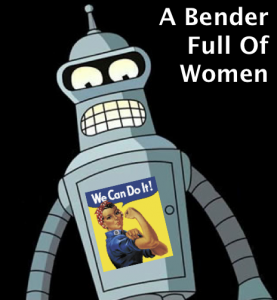 I’ve been flattened by a cold this week, which has been no fun for anyone. Still, the one thing I have managed to keep up with (not the writing or the housework, obviously) is my RSS feed.
I’ve been flattened by a cold this week, which has been no fun for anyone. Still, the one thing I have managed to keep up with (not the writing or the housework, obviously) is my RSS feed.
The Orange Prize in Britain, which has built such a prestigious reputation as a literary prize for women, has lost its sponsorship and is undergoing a rebranding. Luckily, its supporters are not letting that stop them – roll on the Women’s Fiction Prize.
Closer to home, the Stella is being launched in Australia as an equivalent prize to the Formerly-Orange. The first Stella Prize, for a book of fiction or non fiction by an Australian woman writer published in 2012, will be presented next year and you can enter your books now.
Karen Healey takes on the Sleeping Beauty myths, beginning with the story of Brynhildr.
Marvel Now is going back to the beginning with their original X-Men team, and writer Brian Michael Bendis talks about the challenges a teenage Jean Grey will face when she arrives in her own future.
5 Things The Republican Party can learn about Health Policy From Call the Midwife. Actually, this show is useful for anyone who thinks that things were in any way better in ‘the old days.’ It’s a love letter to the NHS to be sure, but also a stark reminder of a world without contraception. (not that contraception is in any way ‘sorted’ in modern day, unless you can afford it, of course)
Sarah Rees Brennan brought attention to this post by Cassandra Clare about the kind of horrific online bullying she and those around her receive on a regular basis. It’s a brave and powerful piece of writing, and I think shows why it is so important to acknowledge online abuse rather than going with the ‘don’t feed the trolls’ mentality which requires the victim to try to make themselves as small a target as possible.
The Mary Sue looks at the interesting use of gender roles to tell a story in computer game “Dishonoured”.
Mary Beard is on a quest to learn whether Roman girls ‘giggled.’
A couple of self-indulgences: the Love and Romanpunk page has been updated on the TPP website to reflect its various awards & nominations, and Narrelle M Harris has written a simply splendid review of Power and Majesty which made me very happy.
Haven’t seen this confirmed by Big Finish on their site, but apparently there will be a series of audio short stories featuring each of the Eleven Doctors to commemorate the 50th Doctor Who anniversary next year. Everyone excited about a new Ninth Doctor adventure should calm down, though, no one mentioned Christopher Eccleston!
Nothing terribly original here but it’s sensible stuff – what writers should know before they go to conferences or conventions.
Apex Magazine are having a subscription drive. I have donated a signed copy of Love and Romanpunk as a prize, though it doesn’t seem to have been included in the list of prizes yet.
October 16, 2012
Two Universes of Angst (Charley Pollard Year 3)
 “SEASON 3” (2003)
“SEASON 3” (2003)
Only two Doctor and Charley stories were released by Big Finish in 2003, and while they continued into 2004 fairly soon after, I thought I’d look at these two separately because they represented such a massive change to the dynamic of the characters, and because the 2004 stories introduced a new companion.
50. Zagreus
Written By: Alan Barnes & Gary Russell
Starring: Paul McGann (the Eighth Doctor), India Fisher (Charley Pollard)
Interesting Guest Star Alert: Peter Davison, Colin Baker, Sylvester McCoy, Anneke Wills, Nicholas Courtney, Elisabeth Sladen, Louise Jamieson, John Leeson, Lalla Ward, Sarah Sutton, Mark Strickson, Nicola Bryant, Bonnie Langford, Sophie Aldred, Caroline Morris, Conrad Westmaas, Maggie Stables, Lisa Bowerman, Stephen Fewell, Robert Jezek, Miles Richardson, Don Warrington.
I found myself arguing with a friend recently that Zagreus could actually be an interesting model for the 50th anniversary Whatever – it takes place entirely in the TARDIS, has a strong focus around the current Doctor and companion, but also makes a place for multiple cameos and small but meaty roles for a huge number of returning Doctor and companion actors.
This three-disc extravaganza was made to celebrate Big Finish’s 50th play in the main range, and of course the 40th anniversary of Doctor Who itself. It was also two months after the announcement that Doctor Who was coming back, which means that the fandom who largely supported these plays would have been surfing a wave of nostalgia, delight, excitement, trepidation and extreme fear for the future.
Remember, we didn’t know yet that it was coming back good.
Zagreus is a glorious, messy celebration of everything that made Big Finish good in its first five years or so, and particularly “their” Doctors.
The premise is that the Doctor has been possessed by a Gallifreyan fairytale monster, Zagreus, and is fighting for his own identity. The TARDIS is likewise struggling with invasion, and deals with this by showing Charley a series of vignettes from the entire span of Gallifreyan history, including the first days of Rassilon’s success in turning mere Gallifreyans into Time Lords (with bonus vampire diplomacy and mystic sisterhood interference), a far future at the end of the universe where the animatronic characters of a defunct amusement park on the ruins of Gallifrey are fighting over the body of their creator, and most crucially, the moment when a group of well-meaning scientists broke a hole into a Divergent Universe and caused this whole crisis in the first place.
All this is tangled up with elements of a particular book which is significant to Charley herself: an edition of Alice in Wonderland given to her as a child. And yes, both the Doctor and Charley represent Alice.
Glorious, complicated, messy.
The pleasure in each of these three set pieces is that the TARDIS is using its memory banks to construct the scenes Matrix-style, and thus the parts are being played not by their original participants, but by past Doctors and the companions they travelled with. So we hear Peter Davison as a batty scientist with the people around him played by Turlough, Nyssa, Peri and Erimem; Colin Baker as an evil vampire lord with Peri, Evelyn and Mel playing the priestesses and vampire assistants around him (at least one of which gets eaten in the process of the story) and Sylvester McCoy in a deeply creepy turn as a dirty old Walt Disney type, woken from cryogenic sleep to see his beloved cartoon animals at war – with Ace, Bernice and Mel playing a variety of those cartoon animals and fairies. Yes, really.
See how this could be a way to bring in old actors to a 50th anniversary special on the telly?
Meanwhile, President Romana is approached by an older and mysterious Leela, whom she has never met despite them both residing (mostly) on Gallifrey – Leela has been living among mystics outside the Capitol, and has a message of great import. The relationship between these two women, so very different in every regard except their history with the Doctor, is a wonderful aspect of this story. The civilised politician and the emotional savage clash constantly, and yet learn to respect each other’s way of doing things so that we are left at the end with a hint of the relationship that would make the Gallifrey series so enjoyable.
Other cameos that pop up include Anneke Wills and Elisabeth Sladen as Charley’s mother and headmistress respectively, in a sequence that takes her through what the response actually was to her disappearance when she stowed away on the R101 airship. Conrad Westmaas who was shortly to become the new Eighth Doctor companion at Charley’s side plays the Cheshire Cat.
Most delightfully of all, eight years before The Doctor’s Wife, Nicholas Courtney as the Brigadier plays the personification of the TARDIS, kindly and helpful to Charley at first, but beginning to crack under the pressure. Because, frankly, after forty years of serving the Doctor as faithfully as she can, the TARDIS herself has rather a lot to say about, for instance, being sacrificed to save Charley in the previous story.
I think that you would need to either have a very strong knowledge of Classic Who OR have listened to a lot of the early Big Finish plays in order to really enjoy this one, but both is probably not required – I certainly listened to it very early on in my Big Finish adventure, and I don’t believe it makes MORE sense now that I’ve listened to nearly everything they have in their archive.
Zagreus is a crazy, surreal, delightful romp, with the Doctor’s very identity at stake. It contains such marvels as a scene in which the Fifth, Sixth and Seventh Doctors await the spirit of the Eighth after he has apparently died, and speculate upon what the next regeneration will bring, assuming there is one at all.
At the end, though, of course, the story is about the Eighth Doctor and Charley, and the crisis that brought them here in the first place. She is a paradox, he is a Time Lord, and someone has to sacrifice themselves to stop the Divergent Universe from destroying our own.
Guess who?
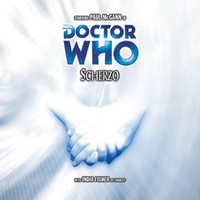 52. Scherzo
52. Scherzo
Written By: Robert Shearman
Starring: Paul McGann (the Eighth Doctor), India Fisher (Charley Pollard)
This is the one I didn’t want to listen to again. Sorry, Rob! It’s a masterpiece, but it’s utterly horrid, and every minute of it is uncomfortable to listen to. This isn’t a criticism. I’m entirely sure that every disturbing layer of horribleness is intentional.
The Doctor is free of the Zagreus possession but still seems to be suffering through a mental breakdown. He sacrificed himself for his own universe, exiling himself to a whole new universe which may well not even have the right stuff to support him as a life form. Never mind oxygen and gravity, this universe doesn’t have time and certainly does not have any possibility of time travel, and that has driven the Doctor over the edge.
Charley, not willing to let him go into exile alone, has stowed away aboard the TARDIS. But the TARDIS herself has become dangerous and unstable in this timeless universe, and the Doctor and Charley have to abandon her, stepping out into the unknown.
If you have ever complained about the lack of realism in science fiction which always assumes that the alien planet will have breathable air and other convenient life supporting networks, and how easily they all communicate with each other… well. Never has an alien planet been more alien. Together, Charley and the Doctor walk through a light so bright that they cannot see, and gradually realise that they are being robbed of all senses but sound.
Sound is the villain here, the alien menace, and it wants to know what makes them tick.
Worst of all, their friendship has irretrievably fractured, with the Doctor resenting Charley for making his sacrifice meaningless, and Charley resenting the Doctor for claiming her loved her without necessarily knowing what the words meant to her.
What they have to do to survive is awful, repulsive, and confronting. If you have a problem with body horror, gruesome consumption of raw meat and, well, gore, then you may struggle with this. I certainly did. It also has what has to be, hands down, the most disturbing possible Doctor-companion kiss. Of all time. Never to be beaten.
The whole play is intelligent, beautifully written, and conveys the idea of ‘alien’ in many different ways. Its use of the audio format, of sound to terrify and to comfort, and its explosion of nearly every Doctor Who/science fiction trope of all kinds is all brilliant.
I still hate it. Yes, it ends with friendship renewed and a sense of hope in this utterly alien universe ahead of them, but I still had to bribe myself to get through every episode. It’s good, I’m not sure Doctor Who has ever been this good before, but it’s so sad and menacing and unsettling that it made my teeth hurt.
Great science fiction, but it scars the soul.
Charley “Season One” reviewed here: Airships, A.I. and Alastair Gordon You Know Who
Charley “Season Two” reviewed here: Chimes, Time and Gallifreyan Rhymes
Agathon #9: The Mystery of the Blue Train [1928]
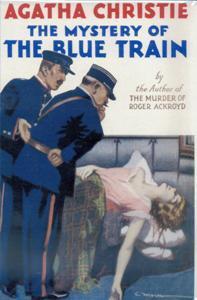
Kathryn and I started out with a challenge to read every book written by Agatha Christie, in order of publication – we’re blogging as we go along. We spoil all the things!
KATHRYN:
So my favorite part of reading ‘The Blue Train’ this time round, was the first sentence of the afterward, which accompanied my copy:
‘In an interview published in 1966, Agatha Christie declared that ‘The Mystery of the Blue Train’ was certainly the worst book she had ever written’. She further described it as ‘commonplace, full of cliches, with an uninteresting plot’.
Like ‘The Big Four’, which preceded it, ‘The Mystery of the Blue Train’ falls in that period of Chiristie’s life when she disappeared and ultimately divorced her husband. While the circumstances in which Christie wrote the book probably colour her opinion, it’s not great, and certainly the cliche part is very true. On many occasions, particularly in the first opening chapters, Christie uses the nationality of a character as shorthand for their personality. Even the heroine of the piece, Miss Katherine Grey is characterised as cool and very English.
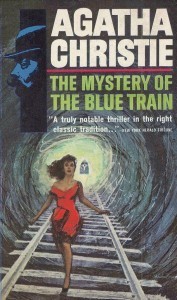 I think the murder plot was serviceable enough. Setting it on the train enabled Christie to mess around with the timing of events, and there are several potential murderers (with of course none of them being the actual murderer!) There are some reasonable twists and misdirections, although I found the accompanying love story a bit meh. The romance of Katherine Grey with both Derek Kettering and Major Knighton is an important component of the mystery. However, they both fall in love with her very quickly, and bounder and philanderer Derek Kettering is eventually redeemed on the back of his murdered (American) wife, and this left a bad taste in my mouth.
I think the murder plot was serviceable enough. Setting it on the train enabled Christie to mess around with the timing of events, and there are several potential murderers (with of course none of them being the actual murderer!) There are some reasonable twists and misdirections, although I found the accompanying love story a bit meh. The romance of Katherine Grey with both Derek Kettering and Major Knighton is an important component of the mystery. However, they both fall in love with her very quickly, and bounder and philanderer Derek Kettering is eventually redeemed on the back of his murdered (American) wife, and this left a bad taste in my mouth.
Probably my favorite pieces of the actual *book* were a couple of exchanges between Poirot, and his newly hired manservant Georges (or George, in the common English). In these Christie produces some very nice characterisation and gentle humor, more reminiscent of that in ‘Roger Ackroyd’. Georges becomes a long standing character, so it was nice to recognise this as his first appearance as well.
The other thing of note is that Miss Grey originally hails from St Mary Mead! We are still to reach a Marple story, so it was interesting to see this mention early on – particularly as Katherine comments that ‘things don’t happen in St Mary Mead’. (I guess they will in a few years!)
I think I liked this one a lot more than Agatha did! Certainly it was miles more enjoyable than “The Big Four.” I think that even though it’s not as clever as some of her other books, it almost is, and you can see the shape of her grand masterwork mysteries going on in the background.
It was very slow to start, especially as it wasn’t obvious which character we were supposed to be following until Katherine turned up – before that it could as easily have been Ruth or her father! And while I would happily have read a much longer book about Katherine and her new life as a wealthy woman, I was sad that Agatha seemed to lose interest in her towards the end, writing her out off camera.
But Poirot is lovely in this one, when he finally appears. He seems to be enjoying life again and I enjoyed his scenes with Georges, with Katherine and with Lenox who totally deserves to be a heroine in her own book.
I did think the twist was rather good, as it was set up RIGHT from the start that the Comte was an obvious blackguard, and Derek just as bad, and the dancer mistress blatantly murderous but too selfish to do it herself… I wondered how on earth you could have a mystery with only two suspects, and to that end had half an eye on Katherine being a very sneaky murderess. But the bit with the male-impersonating maid and especially the revelation that the lovely, awkward pre-murder scene between Ruth and Katherine was not in fact Ruth at all is a beautiful detail. I wonder how on earth they manage to deal with it in a TV/film adaptation, as it only works because this is prose, and third person head-jumping prose at that.
I also liked that the ‘nice guy’ secretary was not in fact the nice guy at all, but that doesn’t mean that Derek deserves Katherine in the least. I hope she comes to her senses, ditches him, and runs off on a girly Mediterranean cruise with Lenox.
The St Mary Mead bit made me giggle. Obviously Miss Marple hasn’t moved there and started murdering people yet!
COMING NEXT:
The Seven Dials Mystery (1929)
[Eileen “Bundle” Brent, Superintendent Battle]
Partners in Crime (1929)
The Mysterious Mr Quinn (1930)
October 15, 2012
Chicks Unravel Skaro
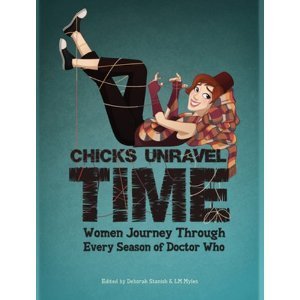 One of my favourite Doctor Who podcasts, Radio Free Skaro, interviews Deb Stanish and L.M. Myles this week about the upcoming book Chicks Unravel Time. I’m so excited to read this book!
One of my favourite Doctor Who podcasts, Radio Free Skaro, interviews Deb Stanish and L.M. Myles this week about the upcoming book Chicks Unravel Time. I’m so excited to read this book!
Liz (or as she is known in Australia among the Friends of Mondy, Scottish Liz) manages to throw several cats among the pigeons by expressing her love of Dodo, The Time Monster, and other Doctor Who glories that go against or at least heartily challenge “fannish wisdom”. Which is, at its heart, one of the aims of the book.
The discussions about Harry and the giant clam were also particularly entertaining because we just watched Genesis of the Daleks this weekend and I had TOTALLY forgotten that it was the one with the giant clams.
Liz and Deb talk about several of the essays and how the book was put together, which I found interesting as a consumer as well as a participant. I was also just a little bit squeeful when Warren mentioned my piece on the Trial of the Time Lord season and my defense of the trial scenes as being the best bits. Which, obviously they are!
Seriously, why has no one in fandom edited together a version of Trial which is just the trial scenes, but with short and entertaining montages from the Doctor’s long career presented as alternate evidence. Or failing that, just the bits that are relevant to the plot (ie the last 5 minutes of Terror of the Vervoids).
Chicks Unravel Time: Women Journey Through Every Season of Doctor Who (Mad Norwegian Press), edited by L.M. Myles and Deborah Stanish, is available for pre-order now and will be released in November.
October 14, 2012
More WSFA
 There’s a trophy! A trophy! I knew this, actually, as I already have one (matching set!) but it’s still exciting to see it. The rundown of the award presentation, including nominee list and a link to my acceptance speech, is here at the actual official page.
There’s a trophy! A trophy! I knew this, actually, as I already have one (matching set!) but it’s still exciting to see it. The rundown of the award presentation, including nominee list and a link to my acceptance speech, is here at the actual official page.
Look, proof that it’s not an elaborate Twitter prank!
I have come down with the cough/cold that has been making my youngest daughter such a crankypants this last week, but still soldiering on because this is my “most potentially productive” day of the week. Even more so as I have unexpected afterschool plans for my eldest.
Then of course I made the mistake of watching the new Downton Abbey over lunch & now I am SO SAD that work seems impossible. For AT LEAST ten minutes. Still, there’s nothing stopping me from doing laundry while sad.
Oh, historical melodrama. Why so painful and angsty? Oh, wait. Answered my own question there. Carry on.
[EDITED TO ADD actual picture of trophy so the post makes sense]
Cherries, Cake and Cheer
 Quite recently, Alisa and I made a pact to do a better job of celebrating our ‘wins’ – between you and me, she’s particularly bad at acknowledging her successes when they roll in.
Quite recently, Alisa and I made a pact to do a better job of celebrating our ‘wins’ – between you and me, she’s particularly bad at acknowledging her successes when they roll in.
Cake, we decided, was the universal currency of yay.
So this morning, when it was announced by @capclave that my story “The Patrician” had won the Washington Science Fiction Association Small Press Award, we declared on Twitter that it was Cake Day! I have to say it was downright patriotic and noble the way that so many of my friends leapt to support the radical concept that cake should be eaten.
Cake has been much on my mind lately. I bought Jane Brocket’s Vintage Cakes and delighted in the pretty, old fashioned cakes in the books, even as I despaired over my daughter Raeli’s reaction to them – nearly every other cake had fruit or cream or both, or jam, or all three, and she heartily disapproves of all of these things in cakes.
But oh, I have been feeling so inclined towards the concept of damp, almondy cherry cake… thus it was that I declared today’s cake an independence cake. I would be allowed to bake it myself, without the assistance of my children (I’m so MEAN) and I would make the kind I wanted to make, again without interference from the peanut gallery. I would let them decorate it, as a compromise. Though I was secretly planning to give them only colour-co-ordinated things with which to do so. Because, have I mentioned? So mean!
 It came late in the day, but while the children bathed themselves (hooray for big girls!) I made a butter cake with sour cream and oranges and ground almonds and okay, not a lot of butter. I was thwarted by my honey who recoiled in horror at the glace cherries I had bought, and begged me not to use them. I AM NOT THE MEANEST PERSON IN THE HOUSE!
It came late in the day, but while the children bathed themselves (hooray for big girls!) I made a butter cake with sour cream and oranges and ground almonds and okay, not a lot of butter. I was thwarted by my honey who recoiled in horror at the glace cherries I had bought, and begged me not to use them. I AM NOT THE MEANEST PERSON IN THE HOUSE!
I made orange cream frosting with sneaky cream cheese (Raeli claimed she didn’t like cream cheese frosting last time) and gave them Maltesers to decorate it with after dinner, because there was no way that wouldn’t look good. But Jem was one ahead of me, insisting that she let me put cherries on top. So lo and behold, there was use for the cherries after all, scattered among the Maltesers so that people who like cherries (me) could have them and people who don’t (everyone else including Jem apparently!) could have slices without.
This seemed fortuitous, because Alisa announced tonight that the wonderful Amanda Rainey has finalised the cover for the first “Livia Day” novel, A Trifle Dead. And there it was, the reason that I might well have had cherries on the brain lately. A whole new chapter for me opening up, as a crime writer!
If only I had some cake or something to celebrate this momentous occasion. Oh, wait.
I am glad I do not live in a world where I have to choose between books and cake. This one looks good enough to eat, blood stains and all!
October 12, 2012
Galactic Suburbia 70 is live
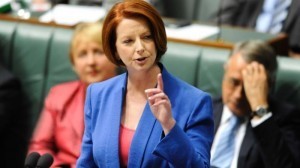 In which Feminism 101 meets Aussie politics for a battle of the bands!
In which Feminism 101 meets Aussie politics for a battle of the bands!
News
Julia Gillard and the Sexists of Doom
The Speech (and bonus Penny Wong Interview)
Commentary in the New Yorker
@vodkandlime talks about the response to the Gillard speech
Ben Peek on the failings of the mainstream media
British Fantasy Awards: special squeeage for Angela Slatter, first Australian to win one.
Jonathan Strahan and Nightshade Book launch Eclipse Online
Strange Horizons Fundraising Drive is on
Crikey looks at author earnings and advances.
What Culture Have we Consumed?
Alex: Deathless, Catherynne M Valente; Arc 1.3; Hydrogen Sonata, Iain M Banks; Looper; abandoned: Armored (ed John Joseph Adams)
Tansy: The Outcast Chronicles, Rowena Cory Daniells; Unspoken, Sarah Rees Brennan; Wild Mary: A Life of Mary Wesley by Patrick Marnham, Under My Hat edited by Jonathan Strahan. Also GAME OF THRONES
Alisa: The Future is Japanese (ed Nick Mamatas); Looper; Death’s Daughter, Amber Benson; Casual Vacancy J K Rowling; Studying Men and Masculinities, David Buchbinder
Next Episode: feedback probably
Please send feedback to us at galacticsuburbia@gmail.com, follow us on Twitter at @galacticsuburbs, check out Galactic Suburbia Podcast on Facebook and don’t forget to leave a review on iTunes if you love us!


